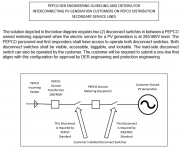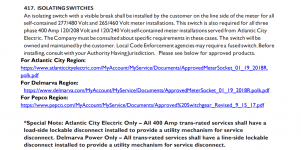pvgreeze
Member
- Location
- Philadelphia
- Occupation
- Electrical Engineer
Hello all, I'm going back and forth with a utility on a design I am working on. The proposed system is to be interconnected on the secondary bushings on an existing pad mounted transformer and is participating in a community solar program, so it is not a typical line side/load side interconnection.
The utility is requiring a "utility disconnect" upstream of the CT cabinet, which is obviously understandable, but then they are requiring a second disconnect immediately downstream of the CT cabinet. I originally proposed a fused DS line side of the CT cabinet and a MLO panel on the load side, which to me was something you would see on a typical new service. I read the utility literature and could not find specific requirements for a singular disconnect on the load side of the CT cabinet. When I inquired, the utility reviewer cited "IEEE/NEC Standards." The reviewer provided no specific code or citation. I initially argued that the line side DS upstream of the CT cabinet could serve as the single disconnecting means as required by 690.13 and 705.22, neither of which states where the switch needs to be sequenced other than that it needs to be between the PV system and the POI.
Am I missing something in 690 or 705? The state is under the 2017 NEC for what its worth. I quickly flipped through both articles (and IEEE 1547) and did not see any mention of the need for a second disconnect. All inverters have dedicated CBs for what its worth per 690.15.
Thanks in advance for any feedback.
The utility is requiring a "utility disconnect" upstream of the CT cabinet, which is obviously understandable, but then they are requiring a second disconnect immediately downstream of the CT cabinet. I originally proposed a fused DS line side of the CT cabinet and a MLO panel on the load side, which to me was something you would see on a typical new service. I read the utility literature and could not find specific requirements for a singular disconnect on the load side of the CT cabinet. When I inquired, the utility reviewer cited "IEEE/NEC Standards." The reviewer provided no specific code or citation. I initially argued that the line side DS upstream of the CT cabinet could serve as the single disconnecting means as required by 690.13 and 705.22, neither of which states where the switch needs to be sequenced other than that it needs to be between the PV system and the POI.
Am I missing something in 690 or 705? The state is under the 2017 NEC for what its worth. I quickly flipped through both articles (and IEEE 1547) and did not see any mention of the need for a second disconnect. All inverters have dedicated CBs for what its worth per 690.15.
Thanks in advance for any feedback.




